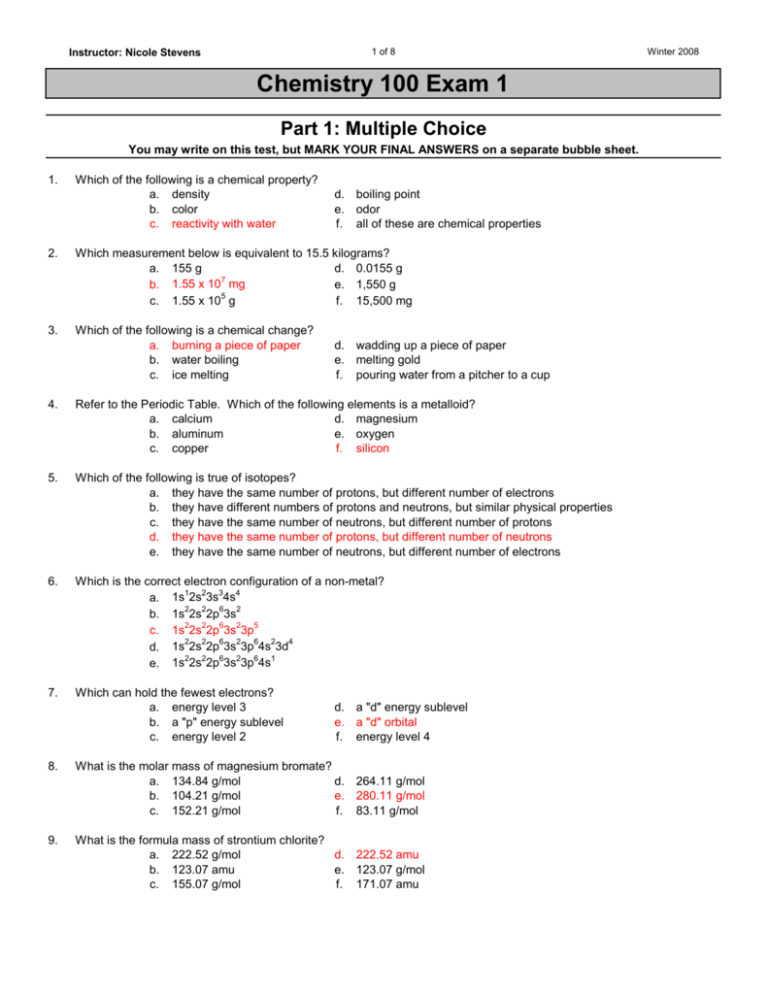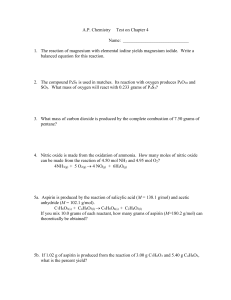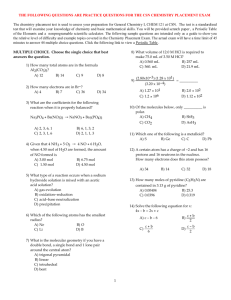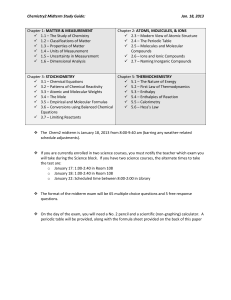Chemistry 100 Exam 1 Part 1
advertisement

1 of 8 Instructor: Nicole Stevens Chemistry 100 Exam 1 Part 1: Multiple Choice You may write on this test, but MARK YOUR FINAL ANSWERS on a separate bubble sheet. 1. Which of the following is a chemical property? a. density b. color c. reactivity with water d. boiling point e. odor f. all of these are chemical properties 2. Which measurement below is equivalent to 15.5 kilograms? a. 155 g d. 0.0155 g 7 b. 1.55 x 10 mg e. 1,550 g 5 c. 1.55 x 10 g f. 15,500 mg 3. Which of the following is a chemical change? a. burning a piece of paper b. water boiling c. ice melting d. wadding up a piece of paper e. melting gold f. pouring water from a pitcher to a cup 4. Refer to the Periodic Table. Which of the following elements is a metalloid? a. calcium d. magnesium b. aluminum e. oxygen c. copper f. silicon 5. Which of the following is true of isotopes? a. they have the same number of protons, but different number of electrons b. they have different numbers of protons and neutrons, but similar physical properties c. they have the same number of neutrons, but different number of protons d. they have the same number of protons, but different number of neutrons e. they have the same number of neutrons, but different number of electrons 6. Which is the correct electron configuration of a non-metal? 1 2 3 4 a. 1s 2s 3s 4s 2 2 6 2 b. 1s 2s 2p 3s 2 2 6 2 5 c. 1s 2s 2p 3s 3p 2 2 6 2 6 2 4 d. 1s 2s 2p 3s 3p 4s 3d 2 2 6 2 6 1 e. 1s 2s 2p 3s 3p 4s 7. Which can hold the fewest electrons? a. energy level 3 b. a "p" energy sublevel c. energy level 2 d. a "d" energy sublevel e. a "d" orbital f. energy level 4 8. What is the molar mass of magnesium bromate? a. 134.84 g/mol d. 264.11 g/mol b. 104.21 g/mol e. 280.11 g/mol c. 152.21 g/mol f. 83.11 g/mol 9. What is the formula mass of strontium chlorite? a. 222.52 g/mol d. 222.52 amu b. 123.07 amu e. 123.07 g/mol c. 155.07 g/mol f. 171.07 amu Winter 2008 2 of 8 Instructor: Nicole Stevens Winter 2008 Chemistry 100 Exam 1 Part 1: Multiple Choice MARK YOUR FINAL ANSWERS on a separate bubble sheet. Match each of the following scientists with the scientific research they did. 10. Rutherford a. b. c. d. e. f. g. h. i. 11. Schrodinger 12. Thomson Wrote The Sceptical Chymist in 1661 Discovered ions, realized atoms were electrical in nature Organized elements into the Periodic Table Coined term "electrons" based on work with cathode-ray tubes Law of Conservation of Mass "Electron cloud" surrounds nucleus, region of probability Proposed an encompassing "atomic theory" Gold-foil experiment suggested atomic structure Oil drop experiment calculated mass of electrons 13. How many molecules of carbon dioxide are present in 1.5 moles of carbon dioxide? 23 a. 1.5 molecule d. 6.022 x 10 molecules 23 b. 66 molecules e. 9.03 x 10 molecules c. 44.01 molecules f. impossible to tell from given information 14. Which atom produces a cation when ionized? a. Al b. O c. P d. S e. He f. all of the above produce anions Match the following to its correct name. 15. a. b. c. d. e. f. g. h. i. j. PO23- 16. NO3 17. Na2SO3 phosphorus dioxide hypophosphate ion sodium sulfate disodium sulfate disodium sulfur trioxide nitrate ion phosphite ion sodium sulfite hypophosphite ion nitrogen trioxide Match the following to its correct formula. 18. Nickel (II) chloride a. Mg3PO2 b. Ni2Cl 19. Magnesium phosphide c. 20. Aluminum hyponitrite d. Mg3P2 e. Al(NO)3 Al3(NO2) 21. What is the correct formula for ammonium carbonite? a. (NH3)2CO2 d. Am2CO2 b. (NH4)2CO2 c. (NH3)2CO3 e. Al2CO2 f. Al2(CO2)3 f. NiCl2 g. Ni2ClO2 h. Mg2P3 i. AlN3 j. AlNO3 g. NH4CO2 h. NH3CO2 i. NH4CO4 3 of 8 Instructor: Nicole Stevens Winter 2008 Chemistry 100 Exam 1 Part 1: Multiple Choice You may write on this test, but MARK YOUR FINAL ANSWERS on a separate bubble sheet. 22. A linear VSEPR molecular shape is characteristic of which of the following? SO22A. H2O B. SO2 C. a. A b. B c. C d. D - NO2 D. CO2 E. e. f. g. h. E A and C A and D A, B and D i. j. C and E all of the above 23. What is the term that means an an average of all an element's isotopes? a. polarity d. molecular shape b. mass number e. electronegativity c. atomic number f. atomic mass 24. A chlorine atom has gained one electron. Which of the following is NOT true about the atom now? a. it is an anion d. it has the same electron configuration as argon b. its mass number increases e. it would be attracted to positive ions and form ionic bonds c. it carries a -1 charge f. all of the above are true 25. Sodium reacts with chlorine gas to form table salt (sodium chloride). In the balanced equation, what are the coefficients in front of sodium and chlorine gas, respectively? a. 3 and 3 d. 3 and 2 b. 2 and 3 e. 3 and 1 c. 2 and 1 f. 1 and 1 Indicate whether the following statements are true or false. a. b. TRUE FALSE 26. The subscripts in a molecular formula represent proportions or ratios of moles. 27. One mole of water contains the same number of molecules as one mole of carbon dioxide. 28. An s-orbital in energy level 1 has both the same shape and the same volume as an s-orbital in energy level 3. 29. Alkaline earth metals react more vigorously with water than alkali metals. 30. p-orbitals are dumbell shaped, while s-orbitals are spherical. 4 of 8 Instructor: Nicole Stevens Winter 2008 Name Chemistry 100 Exam 1 Part 2 : Write-on Please write your answers clearly in the space provided. SHOW ALL WORK! I. Write the full electron configuration for each of the following elements in order of how the orbitals fill. a. Copper b. Krypton II. If a piece of aluminum has a density of 1.73g/mL and a volume of 8.75mL, what is its mass? (Answer to 2 decimal places) III. Convert each of the following measurements into kilometers: a. b. IV. 1.75 x 109 mm 1.45 m Write each of the following in scientific notation: a. 564,000 b. 0.000523 The chemical symbol of the following elements is represented by "X". Refer to the following figures for questions V - VII. 46 23 X a. 46 22 X b. 47 22 X c. V. Which of the above figures are isotopes of each other? VI. Which of the above figures have the same number of neutrons? VII. Figure (b) represents which element from the Periodic Table? 46 21 X d. 48 24 X e. Instructor: Nicole Stevens 5 of 8 Winter 2008 Name Chemistry 100 Exam 1 Part 2 : Write-on Please write your answers clearly in the space provided. SHOW ALL WORK! VIII. Consider a molecule of nitrogen trihydride (ammonia). a. Draw the complete electron-dot configuration of nitrogen trihydride. IX. b. What is the VSEPR molecular shape of this molecule? c. What is the intramolecular force for this molecule? d. What is the intermolecular force for this molecule? e. What state of matter is this compound most likely to be? Perform the following "Roadmap" calculations: (Answers to 2 decimal places) a. How many grams of chromium are present in a sample that contains 3.25 x 1021 Cr atoms? b. How many atoms of oxygen are present in 96.4g of aluminum sulfate? c. How many grams of phosphorus are present in 49.7g of magnesium phosphite? 6 of 8 Instructor: Nicole Stevens Winter 2008 Name Chemistry 100 Exam 1 Part 2 : Write-on Please write your answers clearly in the space provided. SHOW ALL WORK! X. Dihydrogen sulfide reacts with iron (III) perchlorate to form iron (III) sulfide and hydrogen perchlorate. BONUS!! a. Write the balanced equation. b. If I begin with 32.0g of iron (III) perchlorate, how many grams of hydrogen perchlorate will form? (Answer to 2 decimal places) c. If I want to form 60.0g of iron (III) sulfide, how many grams of dihydrogen sulfide to I need to react? (Answer to 2 decimal places) d. What state of matter is the dihydrogen sulfide most likely to be? How can you tell? e. What state of matter is the iron (III) sulfide most likely to be? How can you tell? Instructor: Nicole Stevens 7 of 8 Winter 2008 Chemistry 100 Exam 1 Roadmap to Chemistry Mass Calculations Grams of element Grams of compound A Grams of compound B Molar mass of element (g/mol) Molar mass of compound A Molar mass of compound B Moles of element Subscripts in formula Moles of compound A Avogadro’s number of atoms or ions Avogadro’s number of molecules Atoms or Ions Molecules Atomic mass (amu / atom) Formula mass (amu / molecule) Amu of element Amu of compound Coefficients in balanced equation Moles of compound B








